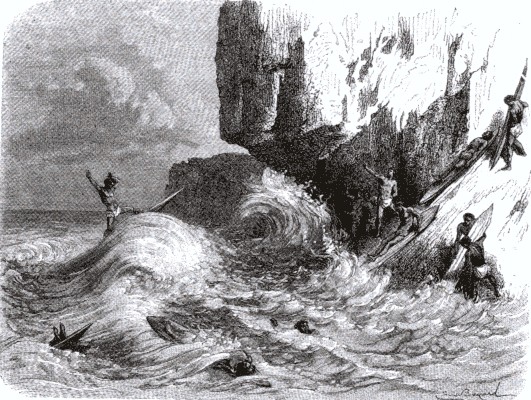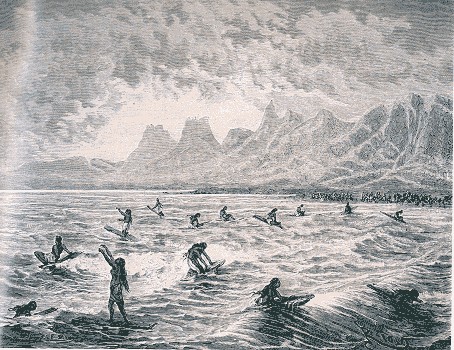 |
surfresearch.com.au
varigny : hawaiians playing, 1874 |
| home | catalogue | history | references | appendix |
|
Quatorze ans aux
iles Sandwich
Librairie Hachette,
Paris, 1874. iii 350p.
Quatorze Ans Aux Iles Sandwich
Varigny Charles
Victor Crosnier De
Le Tour du Monde,
Nouveau Journal des Voyages, publié sous la direction de M. Charton
et illustré par nos plus célèbres artistes, Deuxieme
Semestre, Vol3 6, 1878
Charton, M. Edouard
(Editor)
http://www.aloha-hawaii.com/hawaii/kamehameha+iv/
.
http://www.picturehistory.com/find/p/10717/mcms.html
I have been unable to determine the location of the report.
I assume the text in brackets has been added by the translator to improve explanation.
There only a reference to the board's light weight, and no account of the board's other features or dimensions.
The author notes the decline of surf-riding activity, similarly to Knox : Surfing at Hilo, circa 1888.
With judicious reading, the article appears to imply that the rider slides diagonally across the wave face, and furthermore it could be seen as the first report of a "tube-ride", see Note #8, below.
The two accompanying
illustrations are probably reconstucted from the author's text, field notes,
sketches and/ or verbal input.
It is unlikely the
artists witnessed surf-riding in Hawaii, see Notes #11 and #12.
Riou's image has
a significant inconsistancies.
One could see him then rising on the crest of the waves, descending again, and climbing anew.
After gaining a certain distance from the, beach, he scanned the horizon until a wave stronger than all the others loomed. (4)
The light board, easily maneuvered, was raised like a feather on the crest of the [wave], and [returned] to the shore with the speed of a galloping horse."
The smallest movement would make him capsize. (6)
The man seemed attached to the board and the board itself was one with the surf. (7)
The foam enveloped him, one could see only the outline of his body, and he moved forward with the spray without directing from a straight line and without staggering." (8)
Defiant of danger, natural forces and performed in cold blood were their main attractions.
The chiefs
(masters) excelled at these exercises but now there are few traces of the
games left.
Thus they
had reason to to live, today the cult of body strength has disappeared
with its utility." (10)
 |

2. Probably while padding out "... In the instant there-after, he reappeared on the surface of the water
3. "canoe of
a new genre"
A surfboard of indeterminant
dimensions.
4. "After gaining
a certain distance from the, beach, he scanned the horizon until a wave
stronger than all the others loomed."
Indicates wave selection.
5. "while upright
atop the board."
The rider was in
a standing position.
6. The smallest
movement would make him capsize.
Precise technique
was required to avoid a wipe-out.
7. the board
itself was one with the surf.
Probably an attempt
to describe the transverse motion of the board in the curl.
This is further
expanded ...
8. "The foam
enveloped him, one could see only the outline of his body, and he moved
forward with the spray without directing from a straight line and without
staggering."
The specific indication
that the ridder proceeded in a straight line can only have two possible
interpretations ...
a. The ride
was directly to the beach (which is not reported by similar accounts) and
the rider was "enveloped" by the white water.
b. Following
from 7 above, if the ride was transversed the wave face, then from a contempoarary
perspective, it is almost impossible to read this sentence without considering
that the writer is attempting to describe what is commonly termed a "tube
ride".
9. ".. all
of the old games"
Other games
included land sliding, ??
10. "... there
are few traces of the games left"
Reports the decline
of surf-riding and other traditional activities after European contact,
see Knox (1888)
11. "Emile
Bayard (1837-1891) - French illustrator
Emile Bayard
was born in La Ferté-sous-Jouarre in 1837.
Cogniet's
pupil, he published cartoons in newspapers since he was only 15, sometimes
under the pen name of Abel de Miray.
He made several
drawings on wood using graphite.
Emile Bayard
drew also posters and boards.
As illustator,
he never used photographic documents and always tried to have a meeting
with the author.
The real success
of illustration should be that the reader, just by looking at the paintings,
understands the book.
Bayard made
some drawings on current events, such as Victor Hugo's death.
He actively
collaborated with "Bibliotèque des merveilles", published by Hachette.
He died in
Cairo in 1891.
Works illustrated
by Emile Bayard:
Alphonse Daudet
: Immortel, 51 illustrations.
Hector Malot
: Sans famille, Hetzel.
Comtesse de
Ségur : L'enfant du guide, Hachette, 60 illustrations.
Harriet Beecher-Stowe
: La Case de l'oncle Tom
(Uncle Tom's Cabin)
Jules Verne
: From the Earth to the Moon, Hetzel."
- http://www.ricochet-jeunes.org/eng/biblio/illus/bayard.html
- Arthur B. Evans
: The Illustrators of Jules Verne’s Voyages Extraordinaires
SCIENCE-FICTION
STUDIES, XXV:2 (July 1998): 241-70.
http://jv.gilead.org.il/evans/illustr/
Leuras
(1984) Page 52, notes that that the illustration has "a Tahiti-like backdrop".
Furthermore, there
are several standing riders apparently riding away from the beach.
This is probably
a failure in understanding by the illustrator.

| home | catalogue | history | references | appendix |